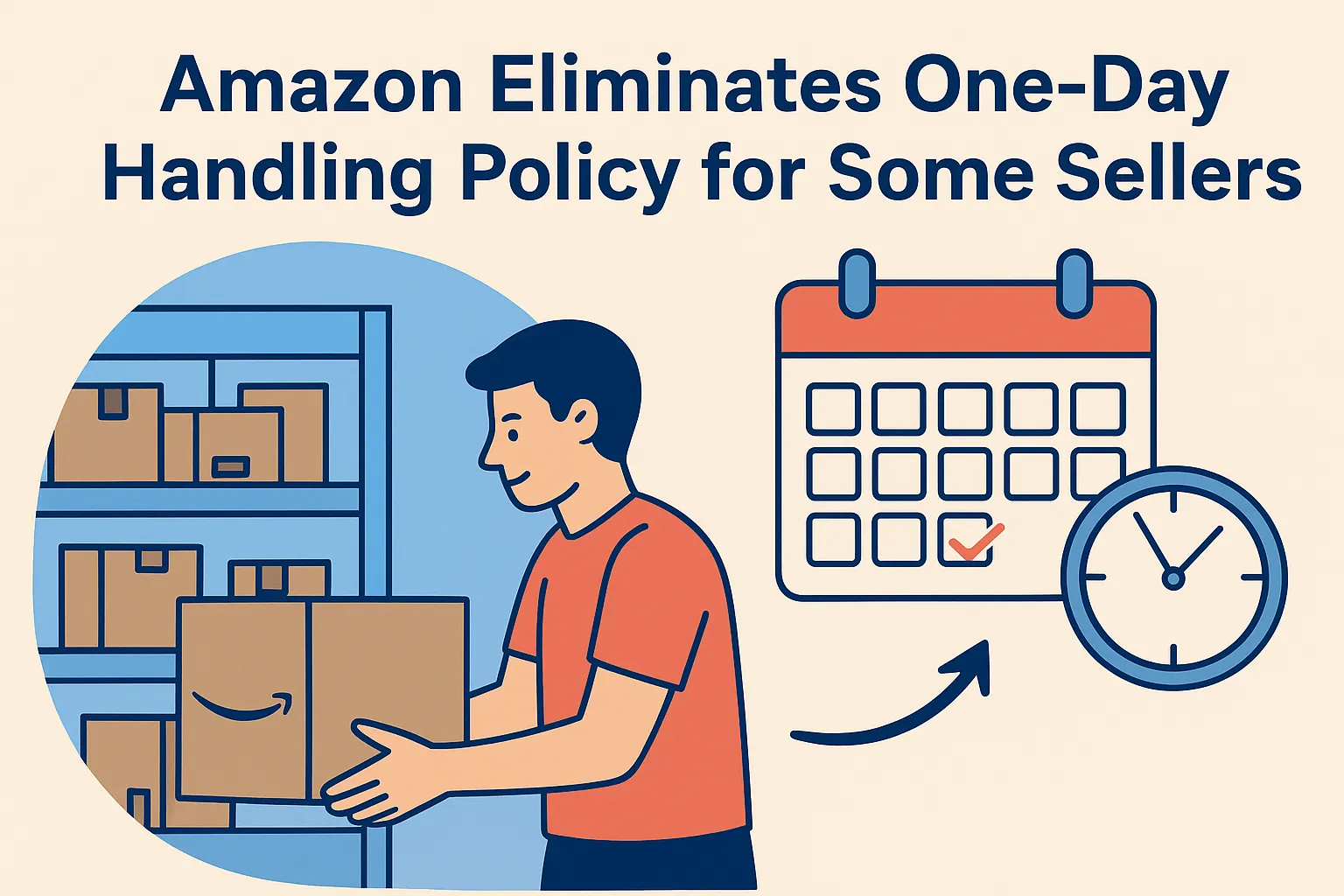Address
304 North Cardinal St.
Dorchester Center, MA 02124
Work Hours
Monday to Friday: 7AM - 7PM
Weekend: 10AM - 5PM

In a major operational update, Amazon is eliminating the one-day handling policy for certain sellers — a move that pushes toward same-day fulfillment expectations.
Starting October 27, 2025, select Premium Sellers will see their order handling time reduced from one day to zero days, signaling Amazon’s next step in speeding up delivery and boosting customer satisfaction.
For U.S.-based sellers and eCommerce brands, this policy brings major implications across fulfillment operations, performance metrics, and profit margins.
Here’s what’s changing, why it matters, and how to stay compliant.
In Amazon’s terms, handling time refers to how long a seller takes to process and ship an order after purchase.
Orders placed between 11 a.m. and 6 a.m. the next morning must still ship by the next day.
This mirrors Amazon’s in-house fulfillment rhythm, designed to deliver faster without compromising order accuracy.
The policy currently targets a select group of high-performing sellers, chosen based on:
In short, Amazon is rewarding operational excellence — but these sellers must now uphold stricter same-day standards.
Failure to comply can affect metrics like Late Shipment Rate (LSR) or Buy Box eligibility.
Amazon’s decision reflects a broader push toward instant commerce and Prime-level delivery speeds.
Key motivations include:
Shoppers increasingly expect near-instant delivery. Same-day handling improves delivery speed, update frequency, and overall satisfaction — reinforcing Amazon’s brand promise.
Synchronizing seller workflows with Amazon’s pace minimizes shipment delays, especially during peak sales periods.
Same-day handling helps Amazon stay ahead of Walmart and Temu, who are expanding their rapid-delivery ecosystems.
Implementing same-day handling may require internal workflow changes.
Here are actionable strategies to stay compliant:
Confirm your cutoff time in Seller Central (typically 11 a.m.). Orders before this must ship the same day.
If needed, move it earlier to ensure packing and dispatch completion.
Not all products can meet zero-day handling.
In Manage All Inventory → Edit Product Info → SKU Handling Time (HT), adjust slower-moving SKUs to 1–2 days to avoid penalties.
Closely track:
Even small delays under the new system can trigger warnings or impact account health.
Though initially applied to China-based accounts, this model will likely expand globally.
U.S. sellers should prepare now by:
Adopt warehouse automation, ERP integrations, and real-time inventory tools to reduce manual handling.
Amazon continues integrating seller performance, fulfillment data, and tax reporting.
Accurate data will be crucial for maintaining compliance and visibility.
| Challenge | Impact | Recommended Solution |
|---|---|---|
| Limited staff capacity | Can’t meet same-day cutoff | Add staggered shifts or outsource fulfillment |
| Inventory gaps | Late or canceled orders | Maintain safety stock for fast-moving items |
| Manual processes | Slower operations | Automate labeling and carrier booking |
| Cutoff confusion | Shipment delays | Set clear internal deadlines aligned with Amazon’s rules |
By removing the one-day handling option, Amazon signals the start of a new logistics era.
Speed is no longer optional — it’s the standard expectation.
Brands that quickly adapt will gain a Buy Box advantage, enjoy higher retention, and position themselves for success in a faster marketplace.
Amazon’s zero-day handling time is a key part of its effort to align third-party sellers with Prime-level logistics.
For sellers, the goal is finding the right balance between compliance and profitability.
Preparation and agility will define tomorrow’s top-performing sellers.
Need help optimizing your Amazon fulfillment strategy or managing handling-time settings?
Our eCommerce operations experts help sellers streamline logistics, reduce ACOS, and protect account health under new policies.
👉 Contact us for a personalized fulfillment audit and strategy plan.
Q1: What does Amazon’s zero-day handling time mean?
It means orders placed before 11 a.m. must be processed and shipped the same day, not the next day.
Q2: Can sellers change handling time back to one day?
Yes. Use the SKU Handling Time (HT) feature in Seller Central to revert certain listings to one-day processing.
Q3: What happens if sellers miss the same-day deadline?
Late shipments can raise your LSR, harm account health, and impact Buy Box eligibility.